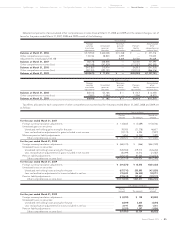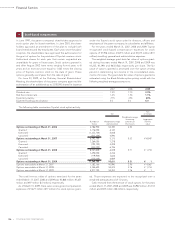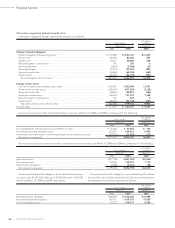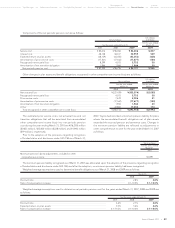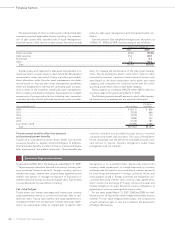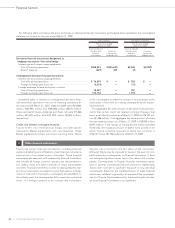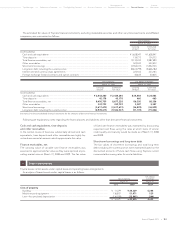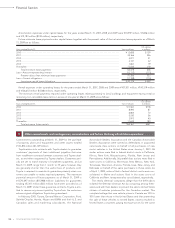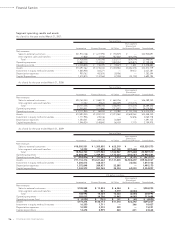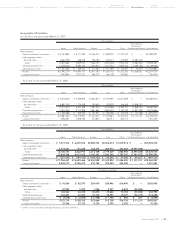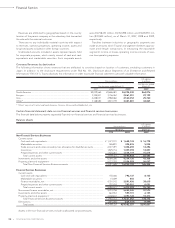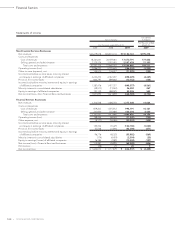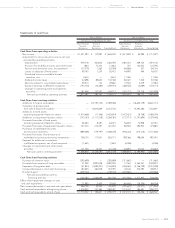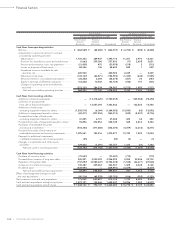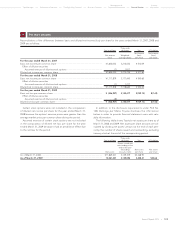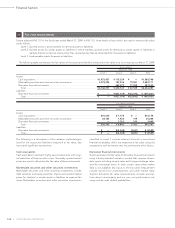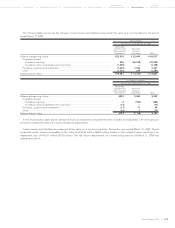Toyota 2009 Annual Report Download - page 97
Download and view the complete annual report
Please find page 97 of the 2009 Toyota annual report below. You can navigate through the pages in the report by either clicking on the pages listed below, or by using the keyword search tool below to find specific information within the annual report.
The Right Way Forward Business OverviewPerformance Overview Financial Section
Investor
Information
Management &
Corporate Information
Top Messages
Annual Report 2009 95
type of vehicles. The complaints seek permanent injunctions
against the alleged antitrust violations and treble damages in an
unspecified amount. In March 2004, the federal district court of
Maine (i) dismissed claims against certain Canadian sales and
marketing subsidiaries, including Toyota Canada, Inc., for lack of
personal jurisdiction but denied or deferred to dismiss claims
against certain other Canadian companies, and (ii) dismissed
the claim for damages based on the Sherman Antitrust Act but
did not bar the plaintiffs from seeking injunctive relief against
the alleged antitrust violations. The plaintiffs have submitted an
amended compliant adding a claim for damages based on state
antitrust laws and Toyota has responded to the plaintiff’s discov-
ery requests. Toyota believes that its actions have been lawful.
In the interest of quickly resolving these legal actions, however,
Toyota entered into a settlement agreement with the plaintiffs
at the end of February 2006. The settlement agreement is pend-
ing the approval of the federal district court, and immediately
upon approval the plaintiffs will, in accordance with the terms of
the settlement agreement, withdraw all pending actions against
Toyota in the federal district court as well as all state courts and
all related actions will be closed.
Toyota has various other legal actions, governmental pro-
ceedings and other claims pending against it, including product
liability claims in the United States. Although the claimants in
some of these actions seek potentially substantial damages,
Toyota cannot currently determine its potential liability or the
damages, if any, with respect to these claims. However, based
upon information currently available to Toyota, Toyota believes
that its losses from these matters, if any, would not have a mate-
rial adverse effect on Toyota’s financial position, operating
results or cash flows.
In October 2000, the European Union brought into effect a
directive that requires member states to promulgate regulations
implementing the following: (i) manufacturers shall bear all or a
significant part of the costs for taking back end-of-life vehicles
put on the market after July 1, 2002 and dismantling and recy-
cling those vehicles. Beginning January 1, 2007, this require-
ment became applicable to vehicles put on the market before
July 1, 2002; (ii) manufacturers may not use certain hazardous
materials in vehicles to be sold after July 2003; (iii) vehicles type-
approved and put on the market after December 15, 2008, shall
be re-usable and/or recyclable to a minimum of 85% by weight
per vehicle and shall be re-usable and/or recoverable to a mini-
mum of 95% by weight per vehicle; and (iv) end-of-life vehicles
must meet actual re-use of 80% and re-use as material or energy
of 85%, respectively, of vehicle weight by 2006, rising respective-
ly to 85% and 95% by 2015. A law to implement the directive
came into effect in all member states including Bulgaria,
Romania that joined the European Union in January 2007.
Currently, there are uncertainties surrounding the implementa-
tion of the applicable regulations in different European Union
member states, particularly regarding manufacturer responsibili-
ties and resultant expenses that may be incurred.
In addition, under this directive member states must take
measures to ensure that car manufacturers, distributors and
other auto-related economic operators establish adequate used
vehicle collection and treatment facilities and to ensure that
hazardous materials and recyclable parts are removed from
vehicles prior to shredding. This directive impacts Toyota’s vehi-
cles sold in the European Union and Toyota is introducing vehi-
cles that are in compliance with such measures taken by the
member states pursuant to the directive.
Based on the legislation that has been enacted to date,
Toyota has provided for its estimated liability related to covered
vehicles in existence as of March 31, 2009. Depending on the
legislation that will be enacted subject to other circumstances,
Toyota may be required to revise the accruals for the expected
costs. Although Toyota does not expect its compliance with the
directive to result in significant cash expenditures, Toyota is con-
tinuing to assess the impact of this future legislation on its results
of operations, cash flows and financial position.
Toyota purchases materials that are equivalent to approxi-
mately 10% of material costs from a supplier which is an affiliat-
ed company.
The parent company has a concentration of labor supply in
employees working under collective bargaining agreements and
a substantial portion of these employees are working under the
agreement that will expire on December 31, 2011.
The operating segments reported below are the segments of
Toyota for which separate financial information is available and
for which operating income/loss amounts are evaluated regular-
ly by executive management in deciding how to allocate
resources and in assessing performance.
The major portions of Toyota’s operations on a worldwide
basis are derived from the Automotive and Financial Services
business segments. The Automotive segment designs, manu-
factures and distributes sedans, minivans, compact cars, sport-
utility vehicles, trucks and related parts and accessories. The
Financial Services segment consists primarily of financing, and
vehicle and equipment leasing operations to assist in the mer-
chandising of the parent company and its affiliate companies
products as well as other products. The All Other segment
includes the design, manufacturing and sales of housing, tele-
communications and other business.
The following tables present certain information regarding
Toyota’s industry segments and operations by geographic areas
and overseas revenues by destination as of and for the years
ended March 31, 2007, 2008 and 2009.
Segment data:
24


